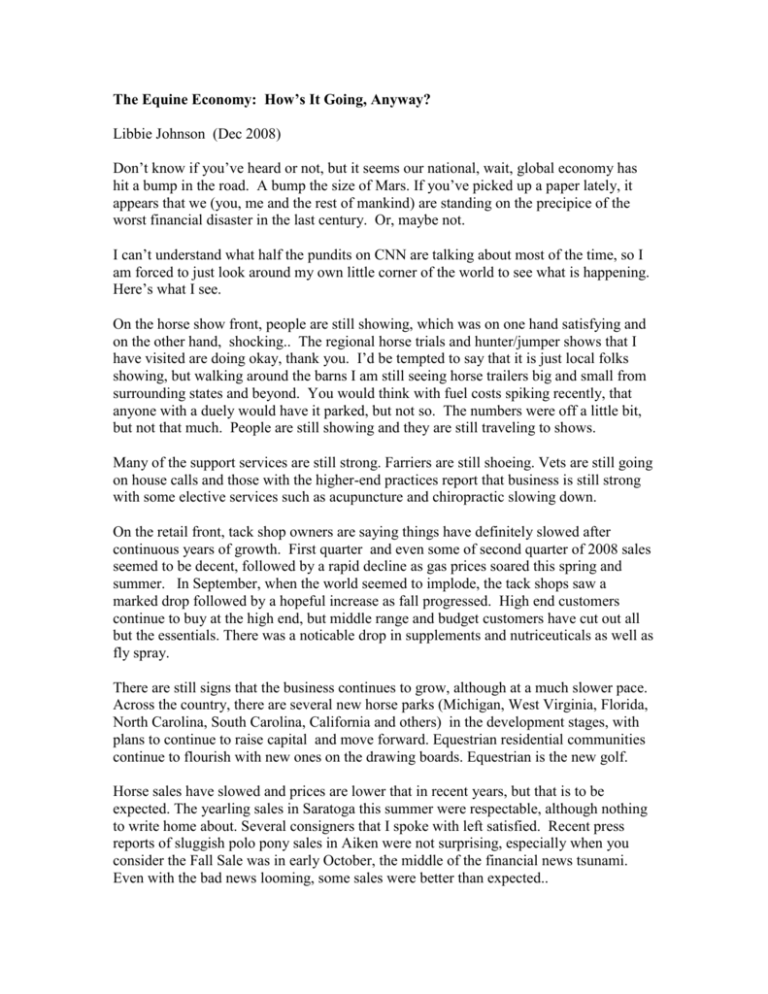The Equine Economy: How`s It Going, Anyway
advertisement

The Equine Economy: How’s It Going, Anyway? Libbie Johnson (Dec 2008) Don’t know if you’ve heard or not, but it seems our national, wait, global economy has hit a bump in the road. A bump the size of Mars. If you’ve picked up a paper lately, it appears that we (you, me and the rest of mankind) are standing on the precipice of the worst financial disaster in the last century. Or, maybe not. I can’t understand what half the pundits on CNN are talking about most of the time, so I am forced to just look around my own little corner of the world to see what is happening. Here’s what I see. On the horse show front, people are still showing, which was on one hand satisfying and on the other hand, shocking.. The regional horse trials and hunter/jumper shows that I have visited are doing okay, thank you. I’d be tempted to say that it is just local folks showing, but walking around the barns I am still seeing horse trailers big and small from surrounding states and beyond. You would think with fuel costs spiking recently, that anyone with a duely would have it parked, but not so. The numbers were off a little bit, but not that much. People are still showing and they are still traveling to shows. Many of the support services are still strong. Farriers are still shoeing. Vets are still going on house calls and those with the higher-end practices report that business is still strong with some elective services such as acupuncture and chiropractic slowing down. On the retail front, tack shop owners are saying things have definitely slowed after continuous years of growth. First quarter and even some of second quarter of 2008 sales seemed to be decent, followed by a rapid decline as gas prices soared this spring and summer. In September, when the world seemed to implode, the tack shops saw a marked drop followed by a hopeful increase as fall progressed. High end customers continue to buy at the high end, but middle range and budget customers have cut out all but the essentials. There was a noticable drop in supplements and nutriceuticals as well as fly spray. There are still signs that the business continues to grow, although at a much slower pace. Across the country, there are several new horse parks (Michigan, West Virginia, Florida, North Carolina, South Carolina, California and others) in the development stages, with plans to continue to raise capital and move forward. Equestrian residential communities continue to flourish with new ones on the drawing boards. Equestrian is the new golf. Horse sales have slowed and prices are lower that in recent years, but that is to be expected. The yearling sales in Saratoga this summer were respectable, although nothing to write home about. Several consigners that I spoke with left satisfied. Recent press reports of sluggish polo pony sales in Aiken were not surprising, especially when you consider the Fall Sale was in early October, the middle of the financial news tsunami. Even with the bad news looming, some sales were better than expected.. However, before we all say whew! too soon, let’s look at the “other side” of the industry ie. the backyard, inexpensive horses. In this category there are some troubling problems. A prolonged draught, coupled with a sagging economy, job loss and unstable fuel prices, have made every day basic maintenance for many horse owners difficult. There are horses that are under nourished or in some cases, starving. Many instances involve owners hoping that their pasture will suffice and as the grass gets thinner and so do the horses. Many reports to Humane Societies and rescue agencies are simply instances of waiting for a better day tomorrow or next week or next month; meanwhile the horses in the pasture are finding it harder to wait. In California and Texas, discount euthanasia clinics are popping up to address the sad state of retired horses, sick horses or horses that are unfortunately a victim of the economy. For a fee of $25.00, participating vets are offering services to horse owners that would otherwise be faced with difficult scenarios of malnutrition or auction to slaughter. One community lessens the sting of having to put down a horse by having a local backhoe driver donate his services in exchange for a donation to a local horse charity. Horse people being horse people are looking for solutions, and they are looking out for their neighbors. In some communities, organized hay drives have been instituted to help those that need it with hay. Sympathetic horse people donate to a special emergency fund for buying hay and a donated secure building to store it,makes it possible for hay to be distributed when necessary. The trick is making sure that people ask for help when they need it. Think of it as a Soup Kitchen for horses. So there you have it. The horse economy is still doing well in some circles, and in some, the scene is devastating. The coming year will be one to watch. Whether the economy and the horse industry can recover or at least result in public policy changes that enables this multi-billion industry to maintain itself remains to be seen. When I mention the equine economy, I often get a “who cares” shrug. And that’s a valid question: why does the horse industry matter? It matters. The horse industry and its economic impact exceeds $102 billion dollars annually. Of that, $40 billion is in goods and services. That’s huge. It is comparable in size to the home furnishings industry or the motion picture industry. The horse industry is a key contributor to the overall fabric of the US economy. Look around and ask yourself who gets hurt if the horse industry sinks? Barn builders. Farriers. Pasture maintenance companies. Truck and trailer sales. Farm laborers. Feed stores. Fence builders. Tractor dealers. Real estate agents. Bedding dealers. Vets and technicians. Retail. Here’s the thing. Horses are not bread on the shelf. It’s a product that lives and breathes and many of us would quite honestly walk through the gates of hell to protect. A horse or horse business is not like selling fertilizer or raising say, blueberries. Horses are an agribusiness that has steadily grown in the past three decades and it’s not something that you get out of easily. Why? Because heart strings and moral responsibility are attached to your product line. And that is what makes this economic entity a horse of a different color.








